
By Karen Rubin, Travel Features Syndicate, goingplacesfarandnear.com
What is inside, and what is outside? What are the boundaries that delineate “interiors”. How much of what is interior is our own perception, our own making? These are the questions explored by three artists – Laini Nemett, Orestes Gonzalez, and Maxi Cohen – represented in “Interiors” on view at the Gold Coast Arts Center in Great Neck, through November 20.
Interiors is an exhibition that explores the artist’s relationship with familiar places and how they connect to interior landscapes of personal history, memory and association. The painter Laini Nemett comments that she wants the composite imagery to conjure memory but also to emulate an experience of place. Orestes Gonzalez’s photographs of interior spaces captures moments of loneliness, happiness and a time of innocence. Photographer/videographer, Maxi Cohen captures moments in the ladies room, “as a space of sanctuary and solitude”.
The only thing common to all is that their creative works “serve as a portal to interior spaces that are in plain sight and yet frequently overlooked,” notes Jude Amsel, Gold Coast Arts Center Gallery Director. They offer a portal to a new way of looking and experiencing what we all take for granted.
Laini Nemett: “Last Door on the Right”
Laini Nemett creates her own sense of place and space – literally. Her paintings stem from imagination – memories and relationships – which go into intricate cardboard models models she constructs at the beginning of her process. She then creates bold paintings that realistically represent these imagined places. They take the viewer in, forcing the viewer to contemplate the scene. It is at that point that the viewer realizes the impossibility of the place – a window that is upside down, a ceiling that has the texture and color of carpeting which should be on the floor.
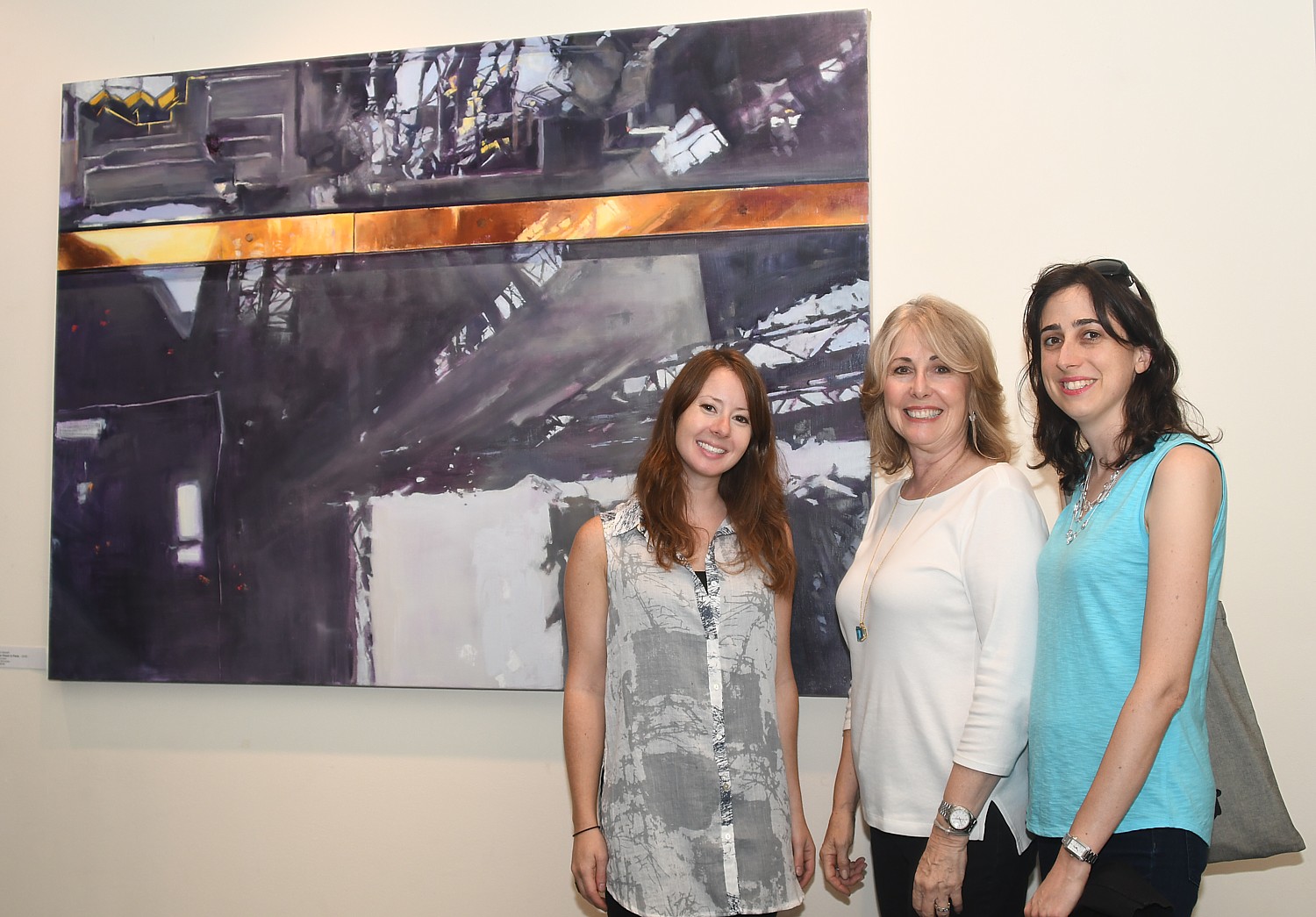
One of the most interesting perspectives stems from a whirlwind visit to Paris and the Eiffel Tower. You would never realize it is the Eiffel Tower because the perspective is looking down from a landing through plexiglass casting a reflection made “wobbly” with rain.
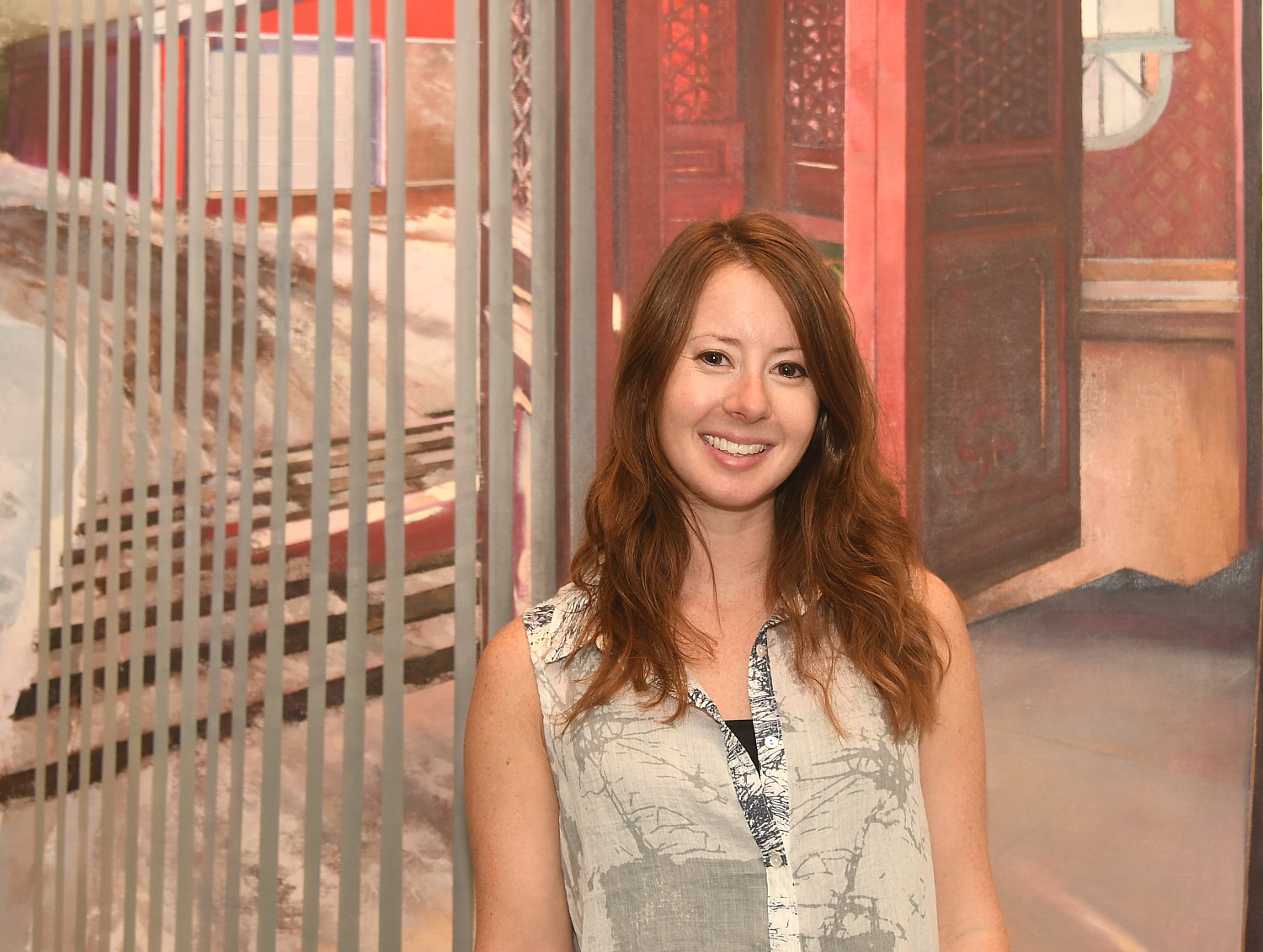
“I assemble my own relics of experience. I discover their logic in the ways they fit together and attempt to make sense of how we decipher place,” Nemett says. One of her paintings in the exhibit is titled “Last Door on the Right.”
“A constant kaleidoscope of imagery the mind sorts at random, concealing and revealing fragments of memories. I choose to disorient myself amidst the puzzle, letting observation suggest the direction.”
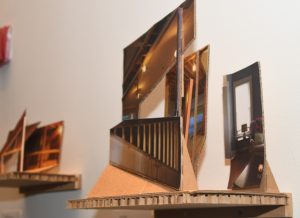
“Extended time in different architectural cultures has shaped how I understand the idea of ‘home.’ In downtown Baltimore, buildings are boarded up and left as skeletons of a family’s history, while new constructions incite possibilities of new beginnings. In the boroughs of New York, old facades are painted away or torn down as new anonymous condo projects begin almost every day. The expansive land of Wyoming holds 100-year old ranches and hand-built homesteads that remain as physical mementos of multiple generations.”
But while the constructions hold the histories and the memories of the people, the paintings are devoid of people altogether. Like a dream, you are surveying the scene.
There is such detail that at first glance, you think you could walk in. But these structures don’t exist – and can’t exist.
“It’s more compelling. I don’t want the painting to answer the questions, but get you to think more, ask more, linger longer. That’s why I paint instead of take photographs. I want to do something that can only happen in painting.”
Orestes Gonzalez: Photographs of Havana, Miami
Orestes Gonzalez also challenges people’s perspective. His black-and-white photographic series from Havana, Cuba, “This Island is My House,” (2016) shows interiors which are really exteriors – a barber who has turned a courtyard into his shop, a building without a roof. Exteriors become interiors and vice versa.
In Cuba, he notes, roof collapses are common, and the lack of materials nad maintenance has created a landscape of ruins in a city of 2 million people.
By necessity, then, “public and private lines are blurred or compromised,” he says. In Cuba, where interior space is very limited or compromised, “interiors are more symbolic rather than literal.” These are people who live their inner lives in a public setting and deal with their environment – their situation – the best they can. In Cuba, the island is the ‘house’ they live in.”
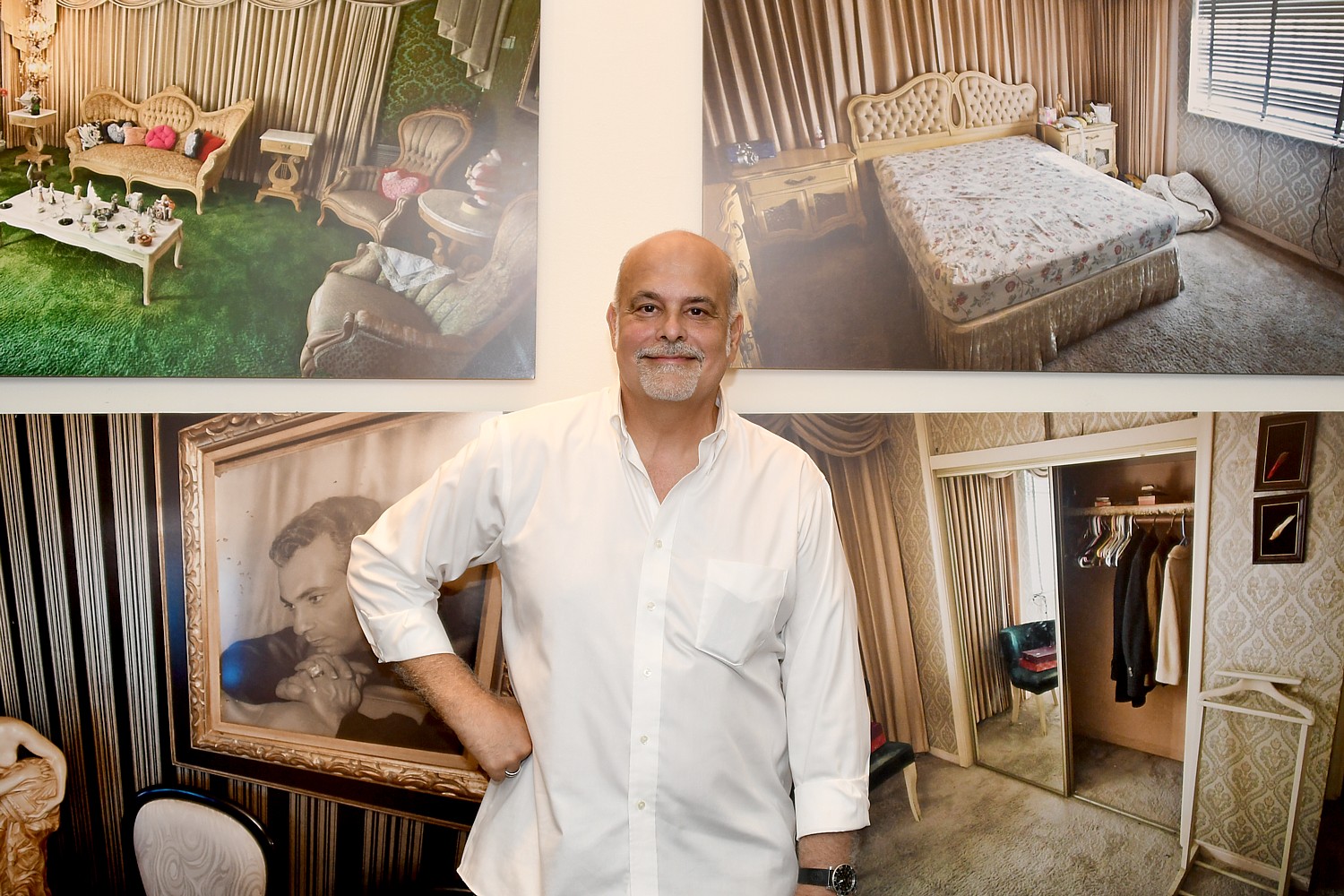
There are also four mural-sized color photographs taken of his Uncle Julio’s apartment in Miami, taken after he passed away. “Julio’s House,” 2007, shows how his interior space was revealing of who he was inside, but afraid to reveal to the outside world.
Maxi Cohen: ‘Ladies Rooms Around the World’
Maxi Cohen, a filmmaker, turned to a different camera in making “Ladies Rooms Around the World.” The series, produced over decades, makes you rethink these customarily private spaces. Her own journey began in 1978 when she was at the Miami Film Festival with her first feature length film documentary, “Joe and Maxi” about her relationship with her father. She retreated to the Ladies room to escape the boring awards dinner and found herself among a gaggle of octogenarians fussing over corsets and false eyelashes. She was entranced by this “tribal dance” and whenever she saw an interesting scene in the ladies room – Australia to Zambia, Bombay to Bosnia, Rio to Tel Aviv, she snapped it. Almost all of them also capture her in the scene – she said she didn’t feel it was right to invade the privacy of others and not include herself. “Since I am recording others in their private rituals, the sanctuaries of women, I have not wanted to separate myself; there is no ‘them’, only ‘we’.” She says.
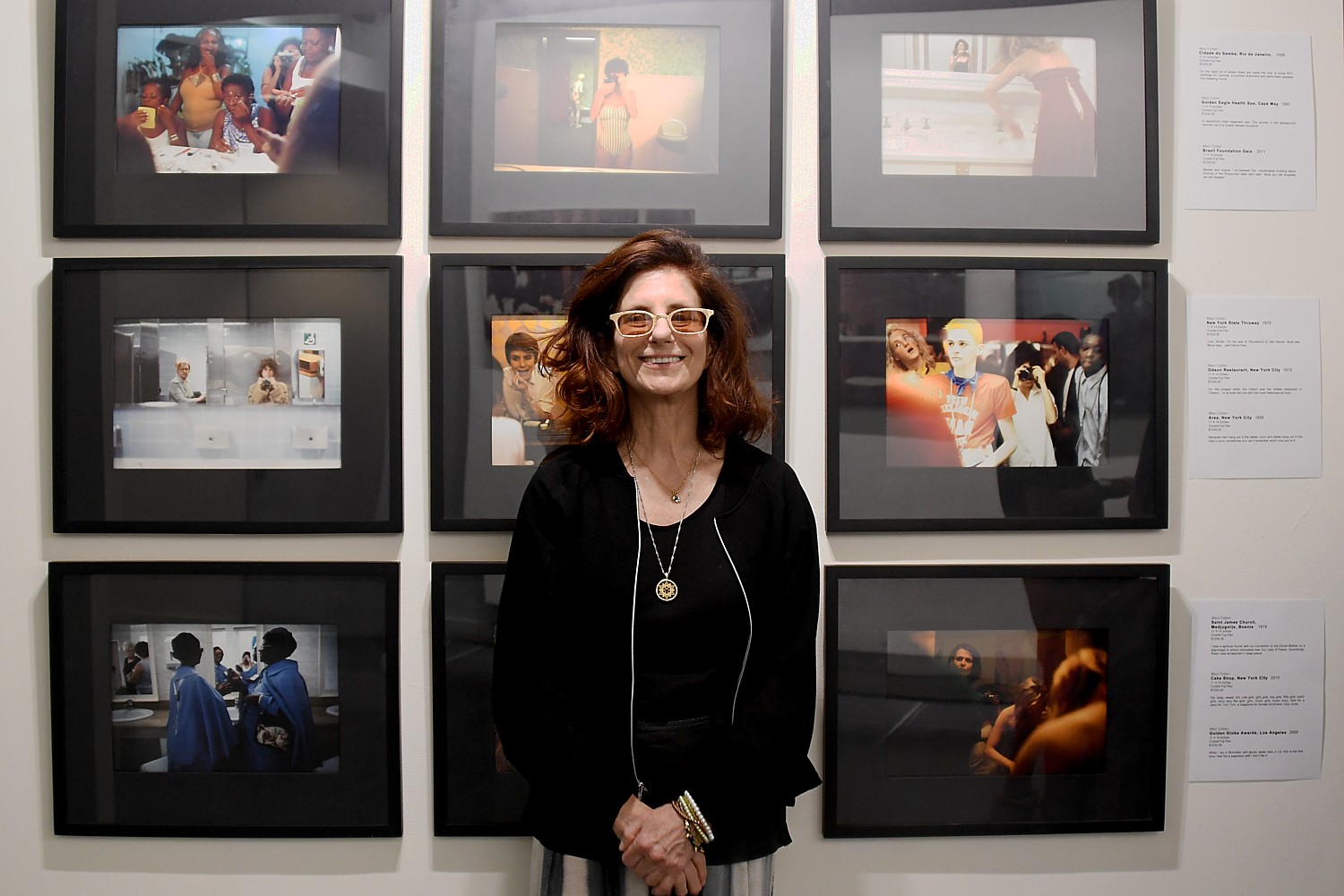
She notes that in the 1990s, she was in an Aboriginal bar in the Australian outback, when women took her into the ladies room to confide in her about the incest and rape of the young boys and girls in the community. In Zambia, she watched as a ladies room attendant would be accepting cash all night, and exchanging little packets in blue tissue paper.
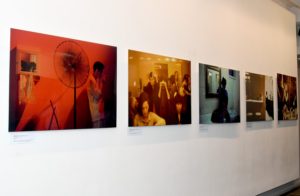
The contrast in places, scenes and colors (since she shoots with available light), not to mention the range of women captured in the images – the New York Thruway, 1978; Livingstone Disco, Zambia, 2003; a film festival in 1981 where Maxi Cohen captures herself in a borrowed gown or possibly robe her friend got from Yoko Ono – is artful and aesthetically pleasing in a way you would never expect hearing about a series of photos of “Ladies Rooms Around the World.”
The Gold Coast Arts Center is located at 113 Middle Neck Road (entrance from the Maple Avenue parking lot), 516-829-2570, goldcoastarts.org.
____________________
© 2016 Travel Features Syndicate, a division of Workstyles, Inc. All rights reserved. Visit goingplacesfarandnear.com and travelwritersmagazine.com/TravelFeaturesSyndicate/. Blogging at goingplacesnearandfar.wordpress.com and moralcompasstravel.info. Send comments or questions to [email protected]. Tweet @TravelFeatures. ‘Like’ us at facebook.com/NewsPhotoFeatures
